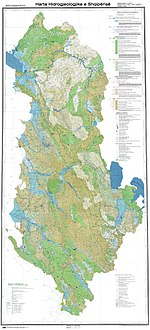
Due to favorable weather conditions, significant tectonic subsidence, karst development, and coastal dynamics, Albania boasts numerous natural and human-made lakes, with varying geographical characteristics, from altitude to water flow, geology, and climate. These features contribute to the specific morphometric elements, water balance, hydrochemical and optical regime of each lake, making classification challenging. Lakes are typically classified based on the origin of the lake basin which plays a crucial role in determining its fundamental geographical characteristics. The country is home to 247 natural lakes and more than 800 artificial lakes. The natural lakes, mostly formed as a result of karstic or glacial processes,[2] are classified as follows: 4 tectonic, 134 proglacial, 94 karst and 15 oxbow. Lagoons are present along the coastal region, covering an area of 150 km2 (58 sq mi).[3]
| No. | Image | Lake | Surface area | Max. depth | Water volume | Map |
|---|---|---|---|---|---|---|
| 1 | 
|
Shkodër | 149 km2 (58 sq mi) | 44 m (144 ft) | ||
| 2 | 
|
Ohri | 111.2 km2 (42.9 sq mi) | 295 m (968 ft) | ||
| 3 | 
|
Prespa | 46.3 km2 (17.9 sq mi) | 54 m (177 ft) | ||
| 4 | 
|
Small Prespa | 4.3 km2 (1.7 sq mi) | 7.7 m (25 ft) |
| No. | Image | Lagoon | Surface area | Max. depth | Water volume | Map |
|---|---|---|---|---|---|---|
| 1 | 
|
Karavasta | 43.3 km2 (16.7 sq mi) | 1.3 m (4 ft 3 in) | ||
| 2 | 
|
Narta | 41.8 km2 (16.1 sq mi) | |||
| 3 | 
|
Butrint | 16.3 km2 (6.3 sq mi) | 21.4 m (70 ft) | ||
| 4 | 
|
Patok | 4.8 km2 (1.9 sq mi) | 0.7 m (2 ft 4 in) | ||
| 5 | 
|
Viluni | 3.0 km2 (1.2 sq mi) |
Other smaller natural or glacial lakes include Lura Lakes, Lake Sheep, Lake Gistova, Lake Gramë, Lake Buni Jezercë, Lake Dash, Lake Sylbicë, Lake Dhënve, Lake Sope and Lake Malik, which was drained by government's decision.
| No. | Image | Lake | Surface area | Max. depth | Water volume | Map |
|---|---|---|---|---|---|---|
| 1 | 
|
Fierza | 70.14 km2 (27.08 sq mi) | 128 m (420 ft) | ||
| 2 | 
|
Vau i Dejës | 25 km2 (9.7 sq mi) | 50 m (160 ft) | ||
| 3 | 
|
Ulëza | 13.5 km2 (5.2 sq mi) | 54 m (177 ft) | ||
| 4 | 
|
Koman | 12 km2 (4.6 sq mi) | 175.5 m (576 ft) | ||
| 5 | 
|
Shkopet | 6 km2 (2.3 sq mi) | |||
| 6 | 
|
Bovilla | 4.6 km2 (1.8 sq mi) | 18 m (59 ft) |
List of lakes of Europe | |
|---|---|
| Sovereign states |
|
| States with limited recognition |
|
| Dependencies and other entities |
|